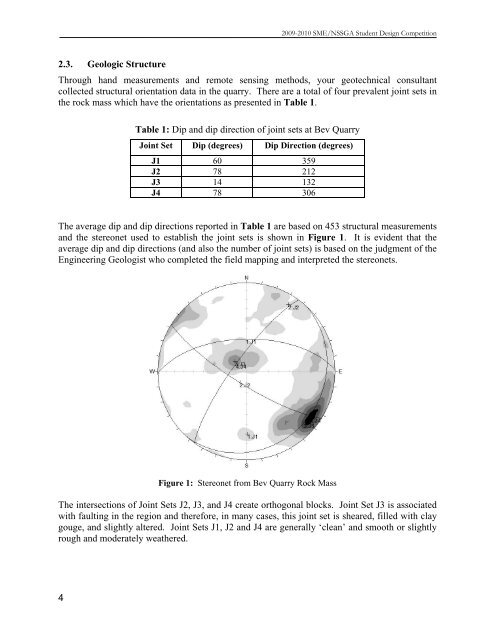2009/2010 Stage 2 Problem Statement - SME
2009/2010 Stage 2 Problem Statement - SME
2009/2010 Stage 2 Problem Statement - SME
You also want an ePaper? Increase the reach of your titles
YUMPU automatically turns print PDFs into web optimized ePapers that Google loves.
<strong>2009</strong>-<strong>2010</strong> <strong>SME</strong>/NSSGA Student Design Competition<br />
2.3. Geologic Structure<br />
Through hand measurements and remote sensing methods, your geotechnical consultant<br />
collected structural orientation data in the quarry. There are a total of four prevalent joint sets in<br />
the rock mass which have the orientations as presented in Table 1.<br />
Table 1: Dip and dip direction of joint sets at Bev Quarry<br />
Joint Set Dip (degrees) Dip Direction (degrees)<br />
J1 60 359<br />
J2 78 212<br />
J3 14 132<br />
J4 78 306<br />
The average dip and dip directions reported in Table 1 are based on 453 structural measurements<br />
and the stereonet used to establish the joint sets is shown in Figure 1. It is evident that the<br />
average dip and dip directions (and also the number of joint sets) is based on the judgment of the<br />
Engineering Geologist who completed the field mapping and interpreted the stereonets.<br />
Figure 1: Stereonet from Bev Quarry Rock Mass<br />
The intersections of Joint Sets J2, J3, and J4 create orthogonal blocks. Joint Set J3 is associated<br />
with faulting in the region and therefore, in many cases, this joint set is sheared, filled with clay<br />
gouge, and slightly altered. Joint Sets J1, J2 and J4 are generally ‘clean’ and smooth or slightly<br />
rough and moderately weathered.<br />
4

















